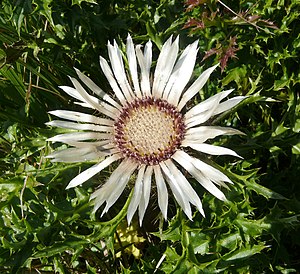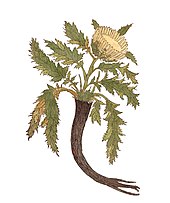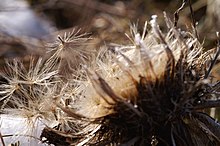Silver thistle
| Silver thistle | ||||||||||||
|---|---|---|---|---|---|---|---|---|---|---|---|---|

Silver thistle ( Carlina acaulis subsp. Acaulis ) |
||||||||||||
| Systematics | ||||||||||||
|
||||||||||||
| Scientific name | ||||||||||||
| Carlina acaulis | ||||||||||||
| L. |
The silver thistle ( Carlina acaulis ) is a plant belonging to the genus of Eberwurzen ( Carlina ) in the subfamily of Carduoideae within the family of the Compositae part (Asteraceae). She was voted flower of the year 1997 .
description
Appearance and leaf
The perennial , herbaceous plant is almost stemless or reaches a height of up to 40 centimeters. With their up to 1 meter deep-reaching tap root the Thistle is considered deep roots. The foliage leaves are cupped, pinnate and thorny serrated to about the middle vein. They usually form a rosette. The underside of the leaf is glabrous to somewhat cobweb. The largest leaves are 4 to 8 inches wide.
Inflorescence and flower
On the stem there is usually only a basket with outer bracts that are shaped like the leaves. The inner bracts are silvery-white on top (rarely a little reddish) and already dead at the time of flowering. These surround the actual flower head, which is composed of a few hundred whitish to reddish tubular flowers . Measured with the inner bracts, the cup reaches a diameter of 50 to 110 millimeters.
The flowering period extends from July to September.
Chromosome set
The chromosome number for both subspecies is 2n = 20.
ecology
pollination

The structure is very similar to that of the Asteroideae , where the tubular florets are often surrounded by ray florets. This enhancement of the visual effect is achieved in the silver thistle through the inner bracts. Unlike tubular flowers, these bracts also reflect UV radiation , which means that insects that perceive ultraviolet light know where to find nectar . This trait is the norm in aster family.
Due to the corolla tube, which is at least 10 millimeters long, pollination can only occur by long-nosed insects, especially bees , bumblebees and butterflies . The thistle weevil Larinus pallinis (Syn. Larinus brevis , Larinus senilis ), which specializes in the silver thistle, has also been observed as a pollinator; its larvae live in the bottom of the basket.
Propagation Mechanisms
The silver thistle has many mechanisms of spread . The achenes can be spread by the pappus as an umbrella flyer with the wind ( anemochory ). But mostly the spread takes place as animal shaker . The thorny bracts attach themselves to passing animals and shake out the fruits. But grain eaters such as birds can also contribute to the spread. Finally, the basket floors are detached from the plant and spread the remaining fruit as a steppe roller .
The weather thistle
When the humidity increases, the dead bracts of the silver thistle absorb more water on the underside of the leaf than on the upper side. Due to this hygroscopic property, the bracts curve upwards and protect the tubular flowers from rain. That is why the silver thistle, just like the golden thistle , is also called weather thistle . If the bracts close, rain is to be expected; in sunshine they open. Breathing on five to ten times is enough to trigger the first righting movement.
Occurrence
distribution
The species is widespread in Europe , from Spain in the west to Romania and Ukraine in the east. The distribution area in Germany extends over the Alps and the Alpine foothills , the Bavarian Forest , the Swabian Alb , the Franconian Alb , the Thuringian Basin , the Rhön and northwards to the edge of the Harz Mountains and a few locations beyond in the Weser-Leine Bergland and in the northern Harz foreland. The species has declined sharply in Upper Lusatia . In the west, north and east of Germany , the species is very rare or completely absent. The silver thistle is legally protected in Germany and is one of the endangered species. In Austria it is common in all federal states.
Location
The preferred location is warm, mostly grazed, poor grassland on soils rich in bases with little humus layer, especially in limestone areas with little rainfall. The silver thistle thrives from the valley up to the subalpine altitudinal zone at altitudes of 2800 meters. In the Allgäu Alps it rises in the Vorarlberg part on Heitersberg and Tyrolean part on the Alpe Kanz on jet head to an altitude of 2,000 meters. Without the management by grazing sheep, the open grasslands below the alpine tree line would be covered with bushes and the silver thistle would disappear there.
The silver thistle is a characteristic species of the half- dry lawn (Mesobromion) lowland; it often grows in the Alps in the order blue-grass lawn (Seslerietalia albicantis).
Systematics
There are two subspecies of the silver thistle, which, in contrast to older views, are not differentiated by the length of the stem, but by the shape of the leaf blade. Both subspecies have morphotypes with sitting and those with stalked baskets.
-
Common silver thistle ( Carlina acaulis
L. subsp. Acaulis )
The middle sections are seated on the leaf spindle with a broad base, about 6 to 15 millimeters wide at the base. The leaf blades are more or less wavy. The sections are divided up to the middle and finely thorny. The stem leaves are evenly distributed ( var. Alpina ) or piled in rosettes under the basket ( var. Acaulis ). The distribution area extends over Germany, Switzerland, Liechtenstein, Austria, the Czech Republic, Italy, Croatia, Slovenia, Bosnia-Herzegovina, Hungary, Slovakia, Poland, Romania, Moldova, Ukraine and Belarus. -
Krausblatt-Silberdistel ( Carlina acaulis subsp. Caulescens (Lam.) Schübl. & G. Martens ; Syn .: Carlina acaulis subsp. Simplex (Waldst. & Kit.) Nyman , Carlina caulescens Lam. , Carlina aggregata Waldst. & Kit. , Carlina alpina Jacq. , Carlina acaulis L. subsp. Aggregata (Waldst. & Kit.) Hegi , Carlina simplex Waldst. & Kit. , Carlina cirsioides Klokov )
The middle sections are seated on the middle field with a narrowed base, at the base about 2 to 6 millimeters wide. The leaf blades are curly. The sections are divided up to the middle and the thorns are a little stronger. The distribution area extends over the countries Spain, Andorra, France, Italy, Germany, Austria, Switzerland, Liechtenstein, Czech Republic, Hungary, Slovenia, Croatia, Bosnia-Herzegovina, Montenegro, Albania, Greece, Crete, Bulgaria, Romania and Slovakia.
Of the two subspecies, the subsp. Occurs almost exclusively in Switzerland and Germany. caulescens before, while subsp. acaulis occurs in the Eastern Alps and in Germany can only be found in individual regions of Bavaria; subsp. caulescens prefers a lime-rich substrate, subsp. acaulis tends to grow on acidic soils.
Origin of name
The name Carlina acaulos, magna flore was already in use before Carl von Linné . By Caspar ileocecal the Thistle as was Carlina acaulis caulifera vel referred. The generic name is probably derived from a northern Italian dialect form cardelina (thistle-shaped clan) via the name of the thistle- fink ( Carduelis carduelis ) from the Latin carduus . A reference to Charlemagne or Emperor Charles V is secondary and has given rise to etymological legends. An angel is said to have shown the silver thistle to Charlemagne in a dream as a true cure for the plague , and it was used in his army; hence supposedly Karlsblume.
The specific epithet acaulis is derived from Latin, it means stemless and refers to the habitus .
Common names
The common name silver thistle refers to the inner, silver-white, shiny bracts. Boar root (or boar thistle) is probably based on its former use in swine diseases. The fleshy flower bases were particularly popular with children. Trivial names such as Jägerbrot (Styria) or Wiesenkas ( Carinthia ) can be traced back to this. The prickly leaves and flower heads are reflected in names such as Oanhagn, meaning hook, 1 hook, Oanhagelwurzen (Bavaria, Austria) or Dornrosen (Carinthia). Names like Frauendistel (Carinthia) are reminiscent of the Feast of the Assumption of Mary , when the silver thistle was often part of the spice tuft . Since the inner bracts close regularly in bad weather and open in sunshine, the plant was used to predict the weather. This is followed by terms such as sun rose, sunnrose (Carinthia), sunflower ( Swabia ), weather thistle, weather rose (Bavaria, Austria) or also summer thistle ( Lower Austria ) and barigmeter, derived from barometer, (Riedschwand, Attergau ). The earlier medical usage is reflected in names like Karlsdistel. Some names also relate directly to the area of distribution, such as rhododistel.
Other German-language trivial names , some of which are only used regionally, are or were: Alpachäs ( St. Gallen near Toggenburg ), Amberwurz, Amberwurz (in the sense of Bärenwurz, Old High German ), Bergdistel (St. Gallen near Werdenberg ), Ebony ( Middle High German ), Eberwurz ( Old High German), Einhackel ( Carinthia ), Einhagenwurzen ( Linz ), Einhaken ( Tyrol in Pinzgau ), Erdwurz (Middle High German), Heberwurz (Middle High German), Hundssporn ( Ulm , Pongau ), Hundszorn (Ulm, Pongau), Jewerwurzel ( Transylvania ), Kraftwurz ( Augsburg , Lechrain ), white horsewort, horsewort, syllable thistle (St. Gallen, Bern ), sunflower ( Memmingen ), Tschöcklein ( Chur ), Tschöggli ( Graubünden ) and weather thistle (Tyrol).
use
The silver thistle is rarely used in modern herbal medicine.
The sharp, aromatic and bitter tasting rhizome contains essential oils, the main components of which are carlina oxide and carligen . The rhizome also contains tannins , resins and inulin . It used to be sold in pharmacies under the name Radix calinae. a. Use as a diuretic, antipyretic, menstruation and perspiration stimulant . It was also used as an aphrodisiac .
The baskets used to be eaten similar to artichokes .
history

In the 15th and 16th centuries the silver thistle was called "Eberwurz" or "English thistle".
An Alsatian manuscript from the 1st quarter of the 15th century described "Eberwurz" as a sexual enhancer for men ("bringet frode vnd machet vnkusch"). They harm pregnant women. Adolescent boys should eat the root for a year so they would gain the strength of three men and retain that strength until they were 40 years old and beyond. If you put the roots of the horses in the stable, they would heat up with it. For heartache, the root should be eaten or drunk in wine.
Paracelsus reported in his “Herbarius” (approx. 1525) miraculous things about the “English thistle”: whoever carries it with him at work deprives his employees of the strength that passes over to him. Otto Brunfels and Hieronymus Bock reported the same thing about the "Eberwurz":
"The Kreütler give away from this root / whoever carries this root at jm / vnd with other people arbeyte / or over feldt gang / or ſonſt beywonung thue / ſo entzyehe ſye others light the strength / and make it powerless / which strengths everyone zů dem / who has ſye bey jm. Darumb ſye bey nyemant tolerated / where one needs alſo. "
“Externally. You give the root to someone else geheie in the carrying / and with someone else about felt / the same ſoll will be deprived of power by the root / believe whoever wants to / I don't find anything written. "
Otto Brunfels also added a picture made by Hans Weiditz in his Contrafeyt Kreüterbuch (page CCXVIII) . This illustration is upside down and does not show the silver thistle, but the stemless scraped thistle ( Cirsium acaule ), as Walther Rytz demonstrated in 1933 using the originals from Weiditz. This thistle was common around Strasbourg, the residence of Brunfels, as reported by Nicolas Ager in Hieronymus Bock's book of herbs (1595, page 314 B).
Others
The coat of arms of the municipality of Böttingen ( Swabian Alb / Baden-Württemberg ) has a stylized silver thistle as a landmark.
swell
literature
- Xaver Finkenzeller, Jürke Grau: Alpine flowers. Recognize and determine (= Steinbach's natural guide ). Mosaik, Munich 2002, ISBN 3-576-11482-3 .
- Ruprecht Düll , Herfried Kutzelnigg : Pocket dictionary of plants in Germany. A botanical-ecological excursion companion to the most important species . 6th, completely revised edition. Quelle & Meyer, Wiebelsheim 2005, ISBN 3-494-01397-7 .
- Dieter Heß: Alpine flowers - Recognize - Understand - Protect. Eugen Ulmer, Stuttgart 2001, ISBN 3-8001-3243-5 .
- Walther Rytz : The Felix Platters herbarium. A contribution to the history of botany of the XVI. Century. In: Negotiations of the Natural Research Society Basel, Volume 44, Pages 1–222. Basel 1933.
- H. Bock: Kreütterbuch . Edited by Melchior Sebiz and Nicolas Ager . Rihel Publishing House, Strasbourg, 1595.
Individual evidence
- ^ Erich Oberdorfer : Plant-sociological excursion flora for Germany and neighboring areas . With the collaboration of Angelika Schwabe and Theo Müller. 8th, heavily revised and expanded edition. Eugen Ulmer, Stuttgart (Hohenheim) 2001, ISBN 3-8001-3131-5 , pp. 958-959 .
- ↑ a b c d e f Gerhard Wagenitz (Hrsg.): Illustrated flora of Central Europe. Pteridophyta, Spermatophyta . Founded by Gustav Hegi. 2nd revised and expanded edition. Volume VI. Part 4: Angiospermae, Dicotyledones 4 (Compositae 2, Matricaria - Hieracium) . Paul Parey, Berlin / Hamburg 1987, ISBN 3-489-86020-9 , pp. 817 ff . (Revised reprint of the 1st edition (Volume VI / 2 from 1929) with addendum).
- ↑ Erhard Dörr, Wolfgang Lippert : Flora of the Allgäu and its surroundings. Volume 2, IHW, Eching 2004, ISBN 3-930167-61-1 , p. 630.
- ^ Manfred A. Fischer, Wolfgang Adler, Karl Oswald: Excursion flora for Austria, Liechtenstein and South Tyrol . 2nd, improved and enlarged edition. Province of Upper Austria, Biology Center of the Upper Austrian State Museums, Linz 2005, ISBN 3-85474-140-5 , p. 924 .
- ↑ a b Werner Greuter (2006+): Compositae (pro parte majore). - In: W. Greuter & E. von Raab-Straube (eds.): Compositae. Euro + Med Plantbase - the information resource for Euro-Mediterranean plant diversity. Datasheet Carlina acaulis In: Euro + Med Plantbase - the information resource for Euro-Mediterranean plant diversity.
- ↑ Anja Nickstadt u. Eckehart J. Jäger, Contributions to the population biology of the silver thistle , in: Hercynia , NF 33.2000, pp. 245–256, here p. 245; The fern and flowering plants of Baden-Württemberg , ed. by Oskar Sebald, Volume 6, 1996, ISBN 3-8001-3343-1 , pp. 225-227; Distribution maps for Bavaria for caulescens and acaulis ; Information on infoflora.ch about caulescens and acaulis .
- ↑ Helmut Genaust: Etymological dictionary of botanical plant names. 3rd, completely revised and expanded edition. Nikol, Hamburg 2005, ISBN 3-937872-16-7 (reprint from 1996).
- ↑ a b Erich Wilhelm Ricek: Dialect plant names from the Attergau. In: Yearbook of the Upper Austrian Museum Association. Year 126, Linz 1981, pp. 189–228 ( PDF on ZOBODAT ).
- ^ City of Waischenfeld, Culture and Customs , accessed on August 11, 2019
- ↑ Entry Silberdistel, Rhöndistel, Wetterdistel, Eberwurz at the Rhön Biosphere Reserve, accessed on August 11, 2019
- ^ Georg August Pritzel , Carl Jessen : The German folk names of plants. New contribution to the German linguistic treasure. Philipp Cohen, Hannover 1882, page 82. ( online ).
- ↑ a b c Entry Carlina acaulis at Plants for a future, accessed on August 11, 2019
- ^ Rita Traversier: Western plants and their effects in the TCM Carl F. Haug Verlag - Thieme Group, Stuttgart, 2014. Page 108ff
- ↑ Frankfurt, Ms. Germ. qu. 17, Alsace 1st quarter of the 15th century, sheet 304rb. (Digitized version)
- ↑ Paracelsus . Herbarius (approx. 1525) (Huser edition 1590, 7th part, pp. 88–92) (digitized version )
- ↑ Otto Brunfels. Contrafeyt Kreueterbuch. Strasbourg 1532, p. 218 (digitized version)
- ↑ Hieronymus Bock. New Kreütter book. Strasbourg 1539, Book II, Cap. 105 (digitized version)
- ↑ Contrafayt Kreüterbůch after right perfect art, vnd description of the old, best-famous doctor, formerly in Teütscher spoke the masszen nye seen ... Johann Schott, Strasbourg 1532, p. CCXVIII (digitized)
Web links
- Silver thistle. In: FloraWeb.de.
- Silver thistle . In: BiolFlor, the database of biological-ecological characteristics of the flora of Germany.
- Profile and distribution map for Bavaria . In: Botanical Information Hub of Bavaria .
- Carlina acaulis subsp. caulescens (Lam.) Schübl. & G. Martens In: Info Flora , the national data and information center for Swiss flora . Retrieved June 9, 2016.
- Thomas Meyer: Data sheet with identification key and photos at Flora-de: Flora von Deutschland (old name of the website: Flowers in Swabia )
- Use in folk medicine





